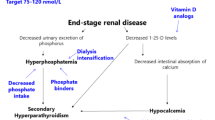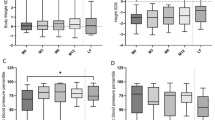Abstract
While the literature has suggested that vitamin D and phosphate therapy benefits children, and possibly adults, with X-linked hypophosphatemia (XLH), there have been increasing reports of nephrocalcinosis by renal ultrasound examination in treated patients. Although it has been assumed that nephrocalcinosis is the result of treatment, there has been no systematic comparison of treated and untreated XLH patients with long-term follow-up. Therefore, we studied 10 adults and 4 children by renal ultrasound examination with no history of medical therapy and 10 adults and 8 children with a history of medical therapy. None of the untreated patients had nephrocalcinosis; 5 treated adults and 5 treated children had nephrocalcinosis. In 3 of 4 treated children, serial renal ultrasounds did not show progression of the nephrocalcinosis. One patient progressed from baseline to year 1 only. Comparisons of means between treated patients without and with nephrocalcinosis showed statistically significant differences for urine calcium/creatinine ratios and urine phosphorus/creatinine ratios, differences not seen between untreated patients and treated patients without nephrocalcinosis. Phosphate dose, but not vitamin D dose, was statistically significantly different between the two treated groups. Our studies point to a convincing role for the association between nephrocalcinosis, as diagnosed by renal ultrasound examination, and medical therapy.
Similar content being viewed by others
References
Chan JCM, Lovinger RD, Mamunes P (1980) Renal hypophosphatemic rickets: growth acceleration after long-term treatment with 1,25-dihydroxyvitamin-D3. Pediatrics 66: 445–454
Costa T, Marie PJ, Scriver CR, Cole DEC, Reade TM, Nogrady B, Glorieux FH, Delvin EE (1981) X-linked hypophosphatemia: effect of calcitriol on renal handling of phosphate, serum phosphate, and bone mineralization. J Clin Endocrinol Metab 52: 463–472
Harrell RM, Lyles KW, Harrelson JM, Friedman NE, Drezner MK (1985) Healing of bone disease in X-linked hypophosphatemic rickets/osteomalacia. J Clin Invest 75: 1858–1868
Marie PJ, Glorieux FH (1982) Bone histomorphometry in asymptomatic adults with hereditary hypophosphatemic vitamin D-resistant osteomalacia. Metab Bone Dis Rel Res 4: 249–252
Reid IR, Hardy DC, Murphy WA, Teitelbaum SL, Bergfeld MA, Whyte MP (1989) X-linked hypophosphatemia: a clinical, biochemical, and histopathologic assessment of morbidity in adults. Medicine (Baltimore) 68: 336–352
Jequier S, Cramer B, Goodyer P, Kronick J, Reade T (1986) Renal ultrasound in metabolic bone disease. Pediatr Radiol 16: 135–139
Goodyer PR, Kronick JB, Jequier S, Reade TM, Scriver CR (1987) Nephrocalcinosis and its relationship to treatment of hereditary rickets. J Pediatr 111: 700–704
Reusz GS, Hoyer PF, Lucas M, Krohn HP, Ehrich JHH, Brodehl J (1990) X linked hypophosphataemia: treatment, height gain, and nephrocalcinosis. Arch Dis Child 65: 1125–1128
Verge CF, Lam A, Simpson JM, Cowell CT, Howard NJ, Silink M (1991) Effects of therapy in X-linked hypophosphatemic rickets. N Engl J Med 325: 1843–1848
Stapleton FB, Noe HN, Jerkins G, Roy S (1982) Urinary excretion of calcium following an oral calcium loading test in healthy children. Pediatrics 69: 594–597
Alon U, Donaldson DL, Hellerstein S, Warady BA, Harris DJ (1992) Metabolic and histologic investigation of the nature of nephrocalcinosis in children with hypophosphatemic rickets and in the Hyp mouse. J Pediatr 120: 899–905
Reusz GS, Latta K, Hoyer PF, Byrd DJ, Ehrich JHH, Brodehl J (1990) Evidence suggesting hyperoxaluria as a cause of nephrocalcinosis in phosphate-treated hypophosphataemic rickets. Lancet 335: 1240–1243
Author information
Authors and Affiliations
Rights and permissions
About this article
Cite this article
Taylor, A., Sherman, N.H. & Norman, M.E. Nephrocalcinosis in X-linked hypophosphatemia: effect of treatment versus disease. Pediatr Nephrol 9, 173–175 (1995). https://doi.org/10.1007/BF00860736
Received:
Revised:
Accepted:
Issue Date:
DOI: https://doi.org/10.1007/BF00860736




